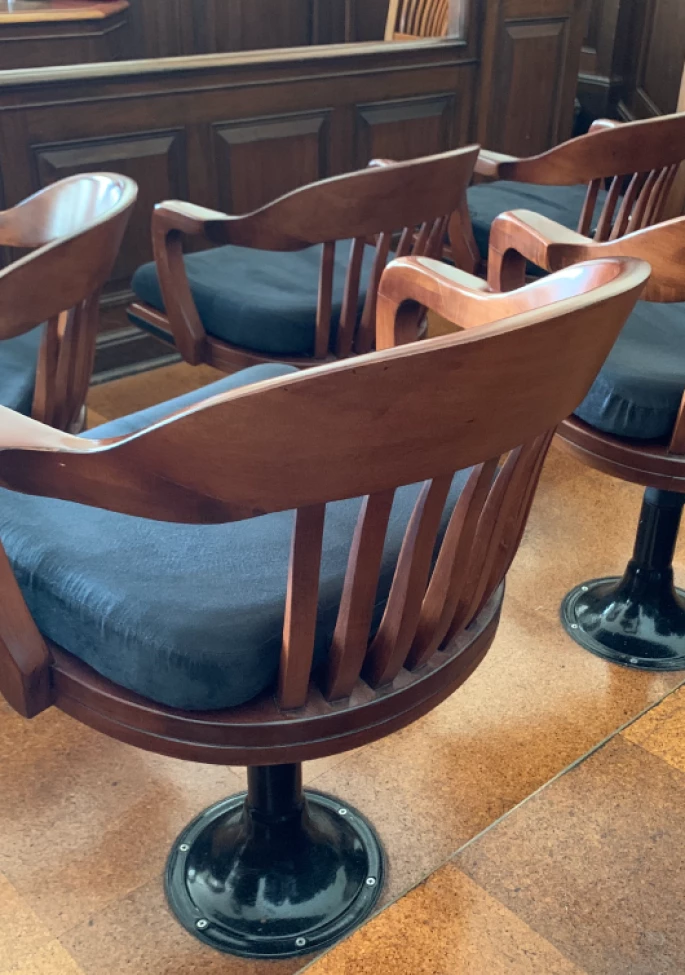Jury selection in the Trump hush-money trial briefly put jury consultants back in the spotlight as media pundits and their contributors discussed the Trump team’s efforts to search prospective jurors’ social media accounts for indications of obvious bias. Whenever a jury consultant was absent from these discussions, we observed no shortage of oversimplifications and faulty characterizations.
It was perhaps the depiction of juror social media research that stood out most, and not just because one contributor referenced “stalking” and Runaway Jury in her explanation.[i] Rather, what was curious is that the media’s simplistic portrayal of this internet research echoes a recent problematic narrative that has led to doubts about its usefulness overall. Many ascribe it a fairly singular goal: to find “smoking guns” of juror bias. With that basic framework, some critics go on to argue that having humans skim the vast web for these clues is usually a waste of time and resources; after all, that is the express purpose of voir dire.
As the age-old legal adage goes, however, “Never ask a question for which you do not already know the answer.” The hidden dangers in jury selection come from those who sit quietly during voir dire, do not raise their hands for many questions, and offer only crumbs on their supplemental juror questionnaire. How much do you know about them, and how much time have you been given to try to learn? It is our view that in-depth social media research—performed by skilled, seasoned professionals—provides trial teams with the colors and shading to paint a fuller portrait of each juror, thus informing the ideal follow-up questions to gently elicit a record for challenges.
After reading and hearing many opinions on the merits of juror social media research, we have identified the four most common criticisms—and the misconceptions driving them.
Misconceptions About Juror Social Media Research
1) Supplemental Juror Questionnaires (SJQs) and Voir Dire Are Enough
"Can’t you learn everything you need to know from a supplemental juror questionnaire and voir dire?"
Ideally, yes. Realistically, no. There are three main reasons:
- Supplemental questionnaires are by no means comprehensive.
Many judges nix them altogether; others prune them to the point of near uselessness. The scope of jurors’ answers is also open to their discretion and interpretation. Answering a work-history question with “retired bus driver” looks straightforward. However, it could omit the heartbreaking story of a career oncologist whose wife lost her longtime battle with cancer, at which point he left the medical field and his old social circle before re-emerging several years later in a new state as a school bus driver. That real-life story was only uncovered through the diligence of a trained searcher.
Even with a detailed SJQ, social media research can guide follow-up questions for voir dire in much the same way their questionnaire responses do. If you see on a juror’s LinkedIn profile that they had a dramatic shift in occupation, you can pose a follow-up question to all jurors, asking about work experiences from the past 10 years rather than just their current job. If a juror appears online to still be struggling with a family death from three years prior, that timeline can inform how you ask the panel about those who have suffered a recent passing.
- Voir dire can be shorter than a network sitcom.
Even in state court, there is hardly enough voir dire time to dig into every juror in all the ways that might reveal bias. Not being adequately prepared means not knowing the right questions to ask to get the responses you need. If you receive the jury list in advance, social media research adds to your preparations by guiding your best follow-up routes during voir dire. Conducted in real time, these searches allow you to compare what you discover online against jurors’ in-person answers, omissions, or silence. It is this complementary nature—the ability to run in tandem with other jury selection efforts—that provides particular value.
- People are people.
Jurors are sworn in prior to voir dire, but some people do not consider omissions to be a lie. An ardent desire for privacy may encourage responses with slim-to-no substance. Jurors might not think the information is relevant. They might be too timid or embarrassed. They might have simply forgotten, only to recollect as the trial details emerge (potentially creating an appealable issue or even a mistrial). And yes, they might just lie. While rare, every attorney’s nightmare is the juror lying in wait, hoping to influence a verdict by veiling their connections to or interest in the parties or subject matter. The Scott Peterson case is one highly publicized example of how alleged juror misconduct by lie or omission can form the basis for a new trial request.[ii]
2) There Is Not Much to Find Online
"The juror population is mostly senior citizens who don’t use social media, right? And aren’t younger people savvy enough to hide themselves?"
Falling for generational biases can seriously misinform your jury selection decisions. While a “Zoomer” might have private profiles that only their chosen audience (friends) can see, they often also have more accessible profiles they use to build a following and promote their art, social causes, or businesses. Meanwhile, as our population’s lifespan rises, retirees increasingly embark on new careers or passion paths. For instance, whereas one might have assumed a single, childless, 82-year-old juror would have no social media presence, we discovered he was in his fourth career after “retiring” twice, had a wide social circle, and actively posted across several platforms on many relevant issues.
The political climate since 2016, not to mention the pandemic, has greatly impacted how people interact with social media, drawing in some users (especially older ones) who may not have had an online presence before. Previously apathetic or silent voters across age groups are now vocalizing their ideologies and support for a variety of causes, both political and charitable.
Social media presence is also better measured by geographic location rather than age. Those in larger cities tend to have their personal profiles locked down tighter, while those in smaller, more rural areas may rely heavily on social media to connect with friends and family or as general entertainment and employ fewer privacy measures.
Yet, no matter where your jurors live and what their privacy settings are, the beauty and bane of social media is that it revolves around connections. Even if a person does not share much or keeps their profile private, they cannot control what others share. Meticulous researchers can locate the social media accounts of a majority of potential jurors, along with relatives and associates, and provide further clues as to how an individual aligns with attorneys’ “juror risk profile” (a developed set of experience and attitude-based variables statistically likely to influence a juror’s view of the case).
3) Most Results Are Irrelevant and Distracting
"Isn’t what you find online just useless filler information?"
Relevancy is best evaluated through the search team’s experiences with similar matters and venues, along with the juror risk profile that has been developed for the present case. Research findings do not stand alone; they flesh out the risk profile with information that may not otherwise have been discovered. For example, since statistically predictive factors are strongest in combination, then if two jurors are otherwise equal but your online research shows that one juror is highly religious and involved in emotional types of volunteerism, your risk profile may tell you that juror is the statistically riskier pick.
Even so, it is quite easy to drown in information overload and lose sight of relevancy. Successful social research requires knowing what to look for, how to distinguish online personas from actual experiences, and how to apply the findings to the risk profile. However, believing that the internet will only overload your trial team with meaningless trivia prevents you from reaping the benefits of a robust juror profile that extends beyond statistical data.
As trained search teams know, even a seemingly innocuous quote or meme can provide insight into a juror’s worldview, optimism or cynicism, sense of personal responsibility, and “locus of control” (the extent to which they believe they have influence over what happens to them). These key attitudes may, among other things, affect their willingness to blame and/or punish others. Shaping all this information into a complete picture of each individual can not only inform your deselection process but also indicate how jurors might behave in deliberations.
In a world where you cannot question every juror to the extent you may wish, having something is always better than nothing—and it may prove critical when choosing who to strike.
4) An AI Sweep Can Do It
"Why not let an AI algorithm scrape the data? Isn’t that cheaper and more powerful?"
AI-led social media research purports to quickly locate juror accounts and scrape relevant data into an attorney-friendly format. Some algorithms even draw conclusions about jurors’ potential demographics and viewpoints, based on apparent trends. AI services posit that they can achieve faster results with less human interaction and fewer omissions.
As remarkable as the promise of AI is, its current social-searching methods have caveats. Some AI algorithms are loaded with compilation profiles of risk factors, but unless they are consistently updated with new experiences, research results, and variables, they can quickly rely on outdated generalizations. AI that focuses on the risk factors of a pre-COVID jury pool, for example, would know little about the jury trends of today. Further, while AI is undoubtedly skilled in delivering fast results and probably cheaper results, it cannot compete with the trained eyes of human searchers.
Juror connections can be found in the smallest details: a comment on a post referring to the juror by a childhood nickname, which turns out to be the username that the juror now uses across all his profiles; a family tree that can be pieced together to explore specific relationships and uncover more information; a cartoon avatar that bears a striking resemblance to the juror. Details like these cannot be mined or swept by current algorithms, nor can AI searches perform any better than the input commands and keywords they receive.
In Conclusion
Common misconceptions like those above cause critics to deem juror social media research a practice in futility. We would argue it is a practice in nuance. The point is not to replace the valuable voir dire Q&A process but rather to supplement it. Both avenues are part of the daunting task of trying, somehow, to develop a three-dimensional image of each potential juror in very little time.
Effective research goes beyond typing the juror’s name into a search engine or a set of keywords into an AI program; it requires creative, human data-collection methods and expert review of that data. With the right team and approach, more information on your potential jurors really is more—especially when a select few will seal your fate.
References
[i] MSNBC. (2024, April 5). Ahead of jury selection, New York judge bolsters gag order with threat Trump can’t ignore. Alex Wagner Tonight. https://www.msnbc.com/alex-wagner-tonight/watch/ahead-of-jury-selection-new-york-judge-bolsters-gag-order-with-threat-trump-can-t-ignore-208457285938
[ii] Associated Press. (2022, February 26). Scott Peterson juror nicknamed “Strawberry Shortcake” denies bias during 2004 trial. KTLA. https://ktla.com/news/california/scott-peterson-juror-nicknamed-strawberry-shortcake-denies-bias-during-2004-trial/







